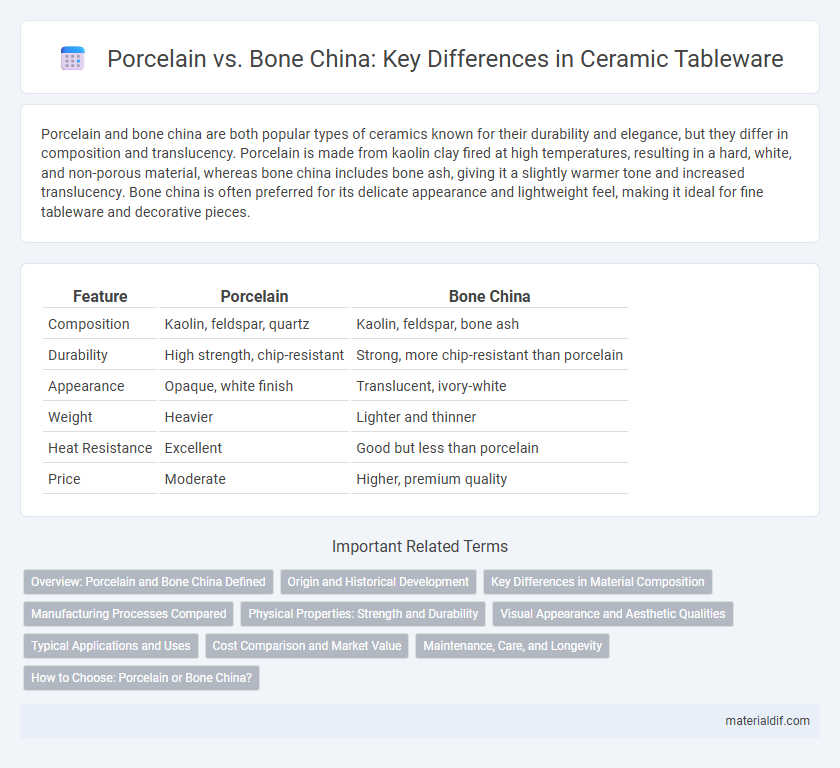Porcelain and bone china are both popular types of ceramics known for their durability and elegance, but they differ in composition and translucency. Porcelain is made from kaolin clay fired at high temperatures, resulting in a hard, white, and non-porous material, whereas bone china includes bone ash, giving it a slightly warmer tone and increased translucency. Bone china is often preferred for its delicate appearance and lightweight feel, making it ideal for fine tableware and decorative pieces.
Table of Comparison
| Feature | Porcelain | Bone China |
|---|---|---|
| Composition | Kaolin, feldspar, quartz | Kaolin, feldspar, bone ash |
| Durability | High strength, chip-resistant | Strong, more chip-resistant than porcelain |
| Appearance | Opaque, white finish | Translucent, ivory-white |
| Weight | Heavier | Lighter and thinner |
| Heat Resistance | Excellent | Good but less than porcelain |
| Price | Moderate | Higher, premium quality |
Overview: Porcelain and Bone China Defined
Porcelain is a durable ceramic material made by firing kaolin clay at high temperatures, resulting in a hard, white, translucent finish often used in dinnerware and decorative objects. Bone china incorporates bone ash along with kaolin and feldspar, producing a lighter, more translucent, and stronger product with a slightly warmer tone compared to traditional porcelain. Both materials share high firing processes but differ in composition, affecting their strength, translucency, and aesthetic qualities.
Origin and Historical Development
Porcelain originated in China during the Tang Dynasty (618-907 AD), renowned for its high-fired, translucent qualities achieved through kaolin clay and feldspar. Bone china emerged in 18th-century England, developed by Josiah Spode, incorporating bone ash to enhance whiteness, strength, and translucency. Both ceramics reflect distinct cultural craftsmanship and technological advancements in their respective regions.
Key Differences in Material Composition
Porcelain is primarily made from a mixture of kaolin clay, feldspar, and quartz, resulting in a dense, non-porous ceramic with a glassy finish. Bone china incorporates bone ash, typically 30-45% of its composition, combined with kaolin and feldspar, which enhances its translucency, whiteness, and strength. The key difference lies in bone china's higher calcium phosphate content from bone ash, offering superior durability and a more delicate appearance compared to porcelain.
Manufacturing Processes Compared
Porcelain is typically made from kaolin clay, feldspar, and quartz, fired at high temperatures around 1,200-1,400degC to achieve its dense, vitrified structure. Bone China incorporates bone ash along with kaolin and feldspar, fired at slightly lower temperatures near 1,100-1,250degC, resulting in a more translucent and lightweight material with enhanced strength. The inclusion of bone ash in Bone China's manufacturing process improves its whiteness and chip resistance compared to standard porcelain.
Physical Properties: Strength and Durability
Porcelain exhibits high strength due to its dense vitrified body, resulting in excellent resistance to chipping and cracking under normal use. Bone china contains bone ash, which enhances its strength and durability, making it more translucent yet still resistant to impact. Both ceramics provide exceptional toughness, but bone china typically offers superior impact resistance and a lighter feel compared to traditional porcelain.
Visual Appearance and Aesthetic Qualities
Porcelain exhibits a smooth, translucent surface with a bright white color that enhances its elegant, timeless appeal. Bone China features a warmer, creamy tone and a higher translucency due to its bone ash content, offering a delicate, refined aesthetic. Both ceramics showcase fine craftsmanship, but Bone China typically presents a softer, more luminous finish compared to the crisp, cool look of Porcelain.
Typical Applications and Uses
Porcelain is commonly used for dinnerware, decorative objects, and bathroom fixtures due to its durability and opacity. Bone china, known for its lightweight and translucency, is favored for fine dining sets and luxury tea wares. Both materials are popular in the hospitality industry, but bone china is preferred for high-end settings because of its elegant finish.
Cost Comparison and Market Value
Porcelain generally costs less than bone china due to its simpler manufacturing process and raw materials primarily consisting of kaolin and feldspar. Bone china, containing bone ash, commands a higher market value because of its translucency, strength, and perceived luxury, often fetching premium prices in fine dinnerware markets. The price difference reflects consumer preferences for durability and elegance, making bone china a favored choice in upscale retail and collector segments.
Maintenance, Care, and Longevity
Porcelain and bone china both require careful maintenance to preserve their delicate surfaces, with porcelain being more resistant to chipping and staining, making it slightly easier to care for. Bone china, containing bone ash, offers superior durability and translucency but demands gentle hand washing to avoid damage from harsh detergents or high heat. With proper handling, both materials can maintain their pristine appearance and functionality for decades, making them long-lasting choices for fine dining and decorative uses.
How to Choose: Porcelain or Bone China?
Choosing between porcelain and bone china depends on factors like durability, translucency, and intended use. Porcelain offers high strength and resistance to chipping, making it ideal for everyday use, while bone china provides a delicate, translucent appearance with added whiteness and a softer feel suitable for formal settings. Consider porcelain for practicality and bone china for elegance when selecting ceramic dinnerware.
Porcelain vs Bone China Infographic

 materialdif.com
materialdif.com